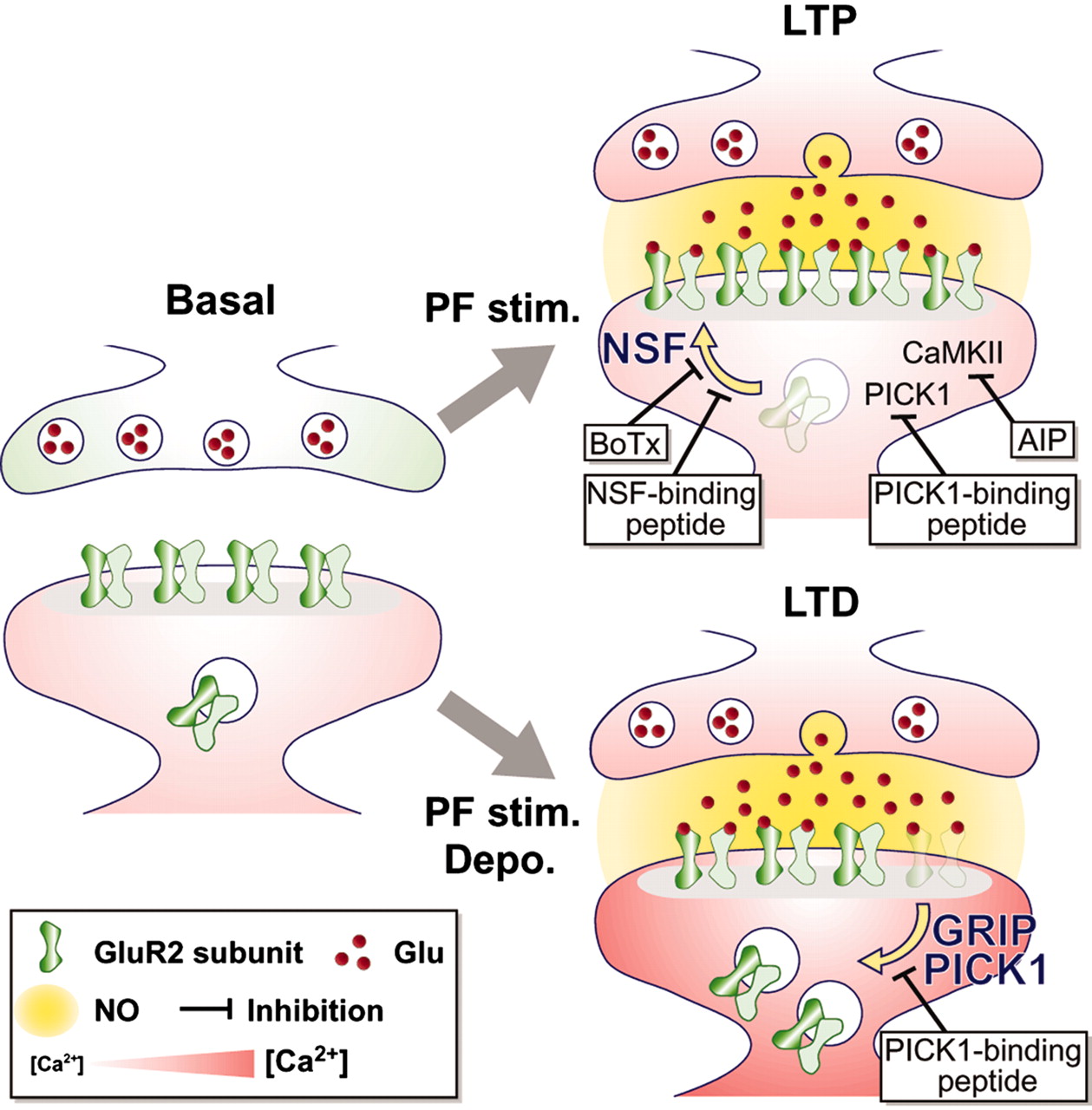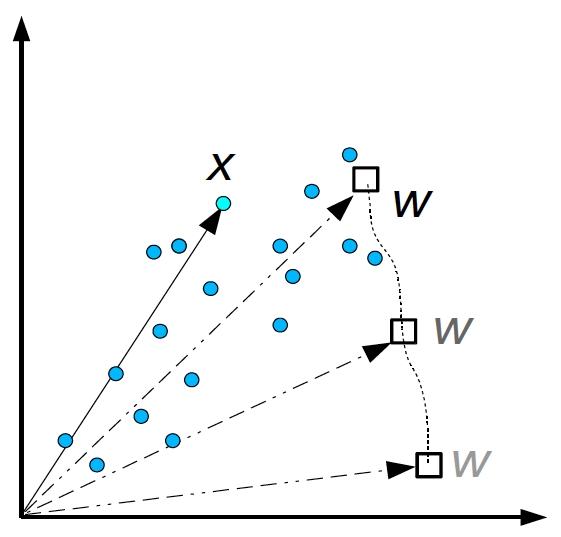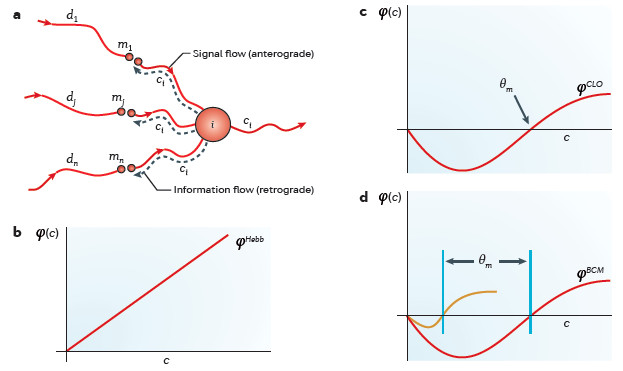





















The basic

In many types of neurons, the synaptic weight \(\textbf{w}\)
is
Synaptic modification can take the form of
The details of these processes — even the vastly oversimplified sketch of the molecular dynamics of LTP and LTD illustrated here — are beyond the scope of the present discussion.

Why it makes sense to define experience in terms of SYNAPSE-level events:
Why it makes sense to consider experience through the lens of STATISTICS:
Why JOINT INPUT&OUTPUT statistics?

What types of learning best describe which NATIVE computations in biological nervous systems?
What about neural computations carried out in VIRTUAL mode?
The Mordor rule:
The
[That's just the short of it. There's A LOT of nuance.]

Consider a neuron with two inputs that computes $$ y = \textbf{w}\cdot \textbf{x} = w_1 x_1 + w_2 x_2 $$
On the right, the input \(\textbf{x}=(x_1,x_2)\) and the weight \(\textbf{w}=(w_1,w_2)\) vectors are plotted together in the same 2D space. The dotted line shows the change that the weight vector undergoes through Hebbian learning (see next slide).
In the plot here, the horizontal and vertical axes are for \((x_1,x_2)\), which is the input space, and for \((w_1,w_2)\), which is the weight space.

Consider a neuron that computes $$ y = \textbf{w}\cdot \textbf{x} = w_1 x_1 + w_2 x_2 $$
Computational analysis carried out in the 1980s* showed
that a neuron with
experience-dependent
In the plot here, the horizontal and vertical axes are for \((x_1,x_2)\) and \((w_1,w_2)\).
* Sanger, T. D. (1989). Optimal unsupervised learning in a single-layer linear feedforward neural network. Neural Networks 2:459-473.
Hebbian learning: a synaptic connection between two neurons increases in efficacy in proportion to the degree of correlation between the mean activities of the pre- and post-synaptic neurons (Donald O. Hebb, 1949).
The Hebb rule in formal notation: the rate of change (time derivative) of the weight \(w_i\) is proportional to the product of the input \(x_i\) and output \(y\) — $$ \begin{matrix} y &=& \sum_i w_i x_i \\ \frac{dw_i}{dt} &=& \eta x_i y \end{matrix} $$ The Oja rule: $$ \frac{dw_i}{dt} = \eta \left(x_i y - y^2w_i\right) $$
To account for much data on synapse modification in response to experience, Bienenstock, Cooper, and Munro (1982) proposed the three postulates of what came to be called the BCM theory:
Principle (2) implies that "the rich [the already strong synapses] get richer and the poor get poorer."

The BCM rule (Intrator and Cooper, 1992): $$ \begin{matrix} y &=& \sigma\left(\sum_i w_i x_i\right) & \ \\ \frac{dw_i}{dt} &\propto & \phi\left(y\right)\cdot x_i &= y\left(y-\theta_M\right)\cdot x_i \\ \theta_M &=& E\left[y^2\right] & \ \end{matrix} $$ where \(E\) denotes expectation (statistical averaging).
This form of BCM can be derived by minimizing a loss (or objective, or cost) function $$ R = -\frac{1}{3} E\left[y^3\right] + \frac{1}{4}E^2\left[y^2\right] $$ that measures the bi-modality of the output distribution. Similar rules can be derived from objective functions based on kurtosis and skewness.
The overarching goal: seek interesting projections — those characterized by a far from the normal distribution (the Central Limit Theorem suggests that projections of a cloud of random points in hi-dim tend to be normal).

(a) For the information required for Hebbian synaptic modification to be available locally at the synapses, information about the integrated postsynaptic firing rate \(c\) must be propagated backwards or retrogradely. The existence of 'back spiking' (dashed lines) was confirmed experimentally and shown to be associated with changes in synaptic strength.
(b) Simple Hebbian modification assumes that active synapses grow stronger at a rate proportional to the concurrent integrated postsynaptic response; therefore, the value of \(\phi\) increases monotonically with \(c\).
(c) The CLO (Cooper, Liberman, and Oja) theory combined Hebbian and anti-Hebbian learning to obtain a more general rule that can yield selective responses. When a pattern of input activity evokes a postsynaptic response greater than the modification threshold (\(\theta_m\)), the active synapses strengthen; otherwise, the active synapses weaken.
(d) The BCM (Bienenstock, Cooper and Munro) theory incorporates a sliding modification threshold that adjusts as a function of the history of average activity in the postsynaptic neuron. This graph shows the shape of \(\phi\) at two different values of \(\theta_m\). The orange curve shows how synapses modify after a period of postsynaptic inactivity, and the red curve shows how synapses modify after a period of heightened postsynaptic activity.

What is a good theory? The usefulness of a theory lies in its concreteness and in the precision with which questions can be formulated. A successful approach is to find the minimum number of assumptions that imply as logical consequences the qualitative features of the system that we are trying to describe. As Einstein is reputed to have said: “Make things as simple as possible, but no simpler.” Of course there are risks in this approach. We may simplify too much or in the wrong way so that we leave out something essential or we may choose to ignore some facets of the data that distinguished scientists have spent their lifetimes elucidating. Nonetheless, the theoretician must first limit the domain of the investigation: that is, introduce a set of assumptions specific enough to give consequences that can be compared with observation. We must be able to see our way from assumptions to conclusions. The next step is experimental: to assess the validity of the underlying assumptions if possible and to test predicted consequences.
A ‘correct’ theory is not necessarily a good theory. For example, in analysing a system as complicated as a neuron, we must not try to include everything too soon. Theories involving vast numbers of neurons or large numbers of parameters can lead to systems of equations that defy analysis. Their fault is not that what they contain is incorrect, but that they contain too much.
Theoretical analysis is an ongoing attempt to create a structure — changing it when necessary — that finally arrives at consequences consistent with our experience. Indeed, one characteristic of a good theory is that one can modify the structure and know what the consequences will be. From the point of view of an experimentalist, a good theory provides a structure in to which seemingly incongruous data can be incorporated and that suggests new experiments to assess the validity of this structure. A good theory helps the experimentalist to decide which questions are the most important.
So, what is it that neurons compute (natively)?
Last modified: Tue Apr 15 2025 at 09:04:42 EDT